Now fresh tomatoes are sold in the store all year round. But the taste of vegetables purchased in winter does not always meet expectations. Therefore, it is worth a little work and start growing your own tomatoes on the windowsill in the winter, using the best varieties in an ordinary apartment. It is only necessary to provide the plants with good care. Then in a few months you can enjoy fresh and tasty fruits.
Content
When to sow seeds
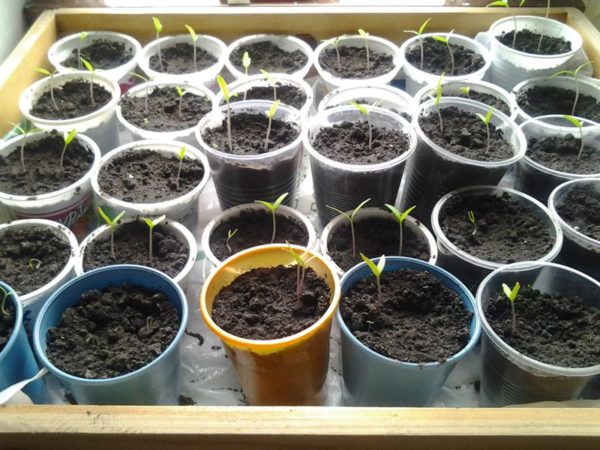 Sowing seeds for growing tomatoes in the winter on the windowsill at home in the apartment is possible for a year. There are no restrictions, as in the usual receipt of seedlings. It is recommended to plant the seed in four batches: the October and November plantings will yield in the winter, and the plants planted in February and March will bear fruit in the summer.
Sowing seeds for growing tomatoes in the winter on the windowsill at home in the apartment is possible for a year. There are no restrictions, as in the usual receipt of seedlings. It is recommended to plant the seed in four batches: the October and November plantings will yield in the winter, and the plants planted in February and March will bear fruit in the summer.
Preparing seeds for planting
The process of growing tomatoes in the apartment and in the garden is the same. To begin with, the seeds are sown for seedlings. For this purpose, do-it-yourself planting material collected or bought is suitable. In both cases, preliminary preparation is carried out:
- Seeds are placed in salt water for sorting. Floating to the surface are rejected, because they are empty and will not give seedlings.
- Good seed is sent to a pinkish potassium permanganate solution for 30 minutes to disinfect.
Capacity for landing
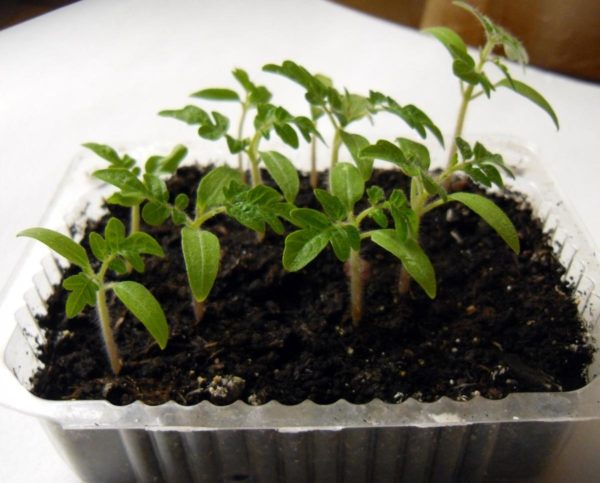 Initially, the seed material is placed in common containers for seedlings. Individual cassettes up to 100 ml in volume will be a good option to grow tomatoes at home in the winter. When the first pair of true leaves appears on seedlings and it becomes closely together, the plants are dived and placed separately in half-liter disposable plastic cups.
Initially, the seed material is placed in common containers for seedlings. Individual cassettes up to 100 ml in volume will be a good option to grow tomatoes at home in the winter. When the first pair of true leaves appears on seedlings and it becomes closely together, the plants are dived and placed separately in half-liter disposable plastic cups.
When 10 pairs of leaves form on a bush, young seedlings are transplanted to a permanent place in a pot with a volume of at least 1 liter per plant. The optimal size is 2-3 liters. At the same time, all containers should be with drainage holes so that moisture does not stagnate. A layer of drainage of expanded clay, crushed brick or other material is placed in a tomato pot at the bottom.
Suitable soil
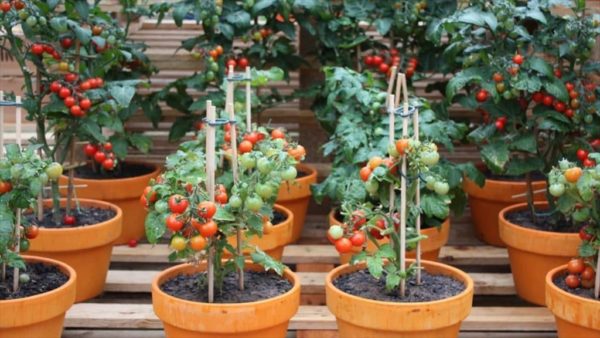 To grow tomatoes in an apartment on a windowsill in the winter, the soil is chosen fertile, with good ability to absorb moisture and let air through. A mixture of forest land and high-quality compost taken in equal volumes is suitable. But a more complex composition is also allowed:
To grow tomatoes in an apartment on a windowsill in the winter, the soil is chosen fertile, with good ability to absorb moisture and let air through. A mixture of forest land and high-quality compost taken in equal volumes is suitable. But a more complex composition is also allowed:
- 2 parts of humus;
- 2 parts of peat;
- 1 part of sand.
When you do not want to bother with mixing the soil yourself, use the store version of the soil to germinate nightshade seedlings.
Sowing and creating conditions for seedlings
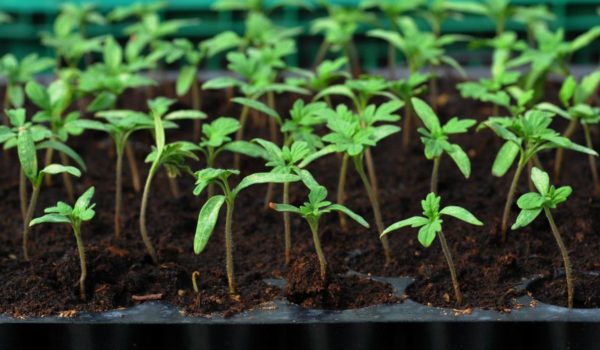 Seeds for growing tomatoes for seedlings are sown in the usual way. Step-by-step process is performed as follows:
Seeds for growing tomatoes for seedlings are sown in the usual way. Step-by-step process is performed as follows:
- The soil prepared in advance is laid in a container for seedlings.
- In a large box, grooves are laid with a depth of 1 to 1.5 cm. If these are individual cassettes, then dig holes in the center.
- The seeds are laid out, observing between them an interval of 2-3 cm. When planting in the cells, 2 seeds are placed in one hole. If two shoots appear, the weaker one is removed.
- Sow seeds sown with earth.
- Spray with warm water from a spray bottle.
Boxes with sown seeds are covered with glass or film is stretched so that the desired microclimate is formed under cover. The containers are moved to a dark place with an air temperature of +22 to +25 degrees, until the first sprouts appear. Periodically, the shelter is removed to access fresh air and regularly moisturized.
When shoots appear, they are moved to a lighted room and at the same time they remove the shelter. If the seedlings grow too thick, it is thinned out. In cloudy weather, plantings are illuminated with phytolamps. If the sun shines brightly, seedlings are shaded so that the rays do not burn it. Three weeks after sowing, the sprouts are fed a weak solution of mineral fertilizer.
Pick
After germination of seedlings, a pick is carried out after 3 weeks. By this time, 3-4 true leaves have already appeared on young plants. Seedlings are carefully separated and transferred to new larger containers. In such pots there is more space for the qualitative development of plant roots.
Transplanting in large pots
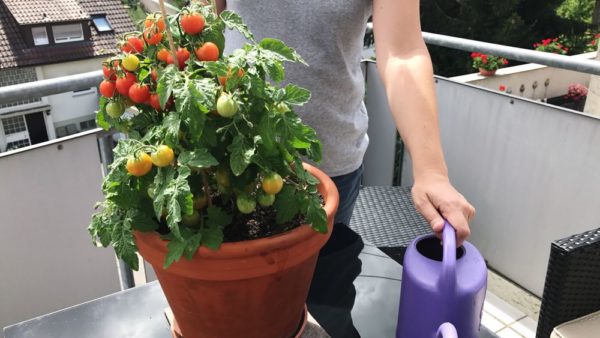 1.5 months after the picking, the final transplant of plants into flowerpots is performed for constant growth. A drainage layer is laid on the bottom of the pot, and then filled with nutrient soil.
1.5 months after the picking, the final transplant of plants into flowerpots is performed for constant growth. A drainage layer is laid on the bottom of the pot, and then filled with nutrient soil.
The capacity is selected, given the varieties of tomato:
- for dwarf varieties, 2 l pots are enough;
- medium-sized tomatoes are planted in a 4-liter container;
- for ampel options use flowerpots of at least 5 liters.
Seedlings are moved by transshipment. To facilitate the task, the plants are watered well the day before, so that when moving the earthen lump retains its shape. The free space at the edges of the pot is then sprinkled with fresh soil.
Care Rules
The condition and quality of the tomato crop largely depends on how well the plants are cared for. For the rapid development at home and the ovary of a large number of fruits, tomatoes are watered and fertilized on time. But first, it is important to provide the plants with the necessary temperature and light conditions.
Illumination and growing place
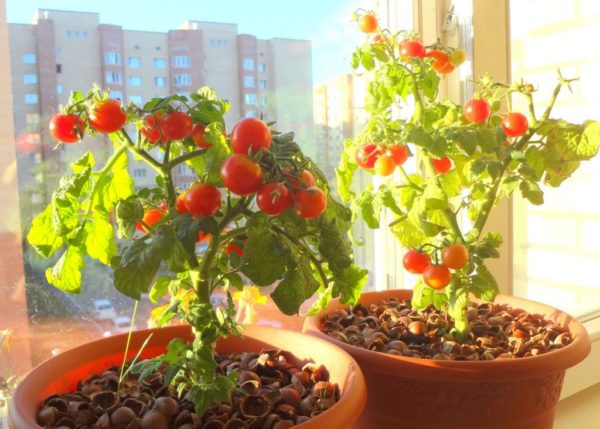 For quality development, tomatoes need a long daylight hours. It is most convenient to provide plants with prolonged natural light for 14-16 hours by placing pots on the south side. It is also allowed to install them on a window facing west or east. In the summer with the onset of heat, it is recommended to take the plants to the balcony or loggia.
For quality development, tomatoes need a long daylight hours. It is most convenient to provide plants with prolonged natural light for 14-16 hours by placing pots on the south side. It is also allowed to install them on a window facing west or east. In the summer with the onset of heat, it is recommended to take the plants to the balcony or loggia.
In winter or early spring, the daylight hours are still insufficient for the rapid growth of tomatoes. Therefore, young plants are additionally illuminated with phytolamps.
Temperature
After seed germination, when the temperature is +20 .. + 25 degrees, the boxes are moved to colder conditions. For high-quality growth, plants need enough temperature during the day from +18 to +20 degrees. At the same time, in winter, when heating works at full capacity, tomatoes can suffer from too dry and hot air. Therefore, the batteries are covered with blankets.
At night, it is recommended to rearrange the pots with tomatoes on the floor in order to lower the ambient temperature by a couple of degrees. Such conditions do not allow plants to stretch. With the onset of summer, homemade tomatoes are moved to the open balcony.
Humidity
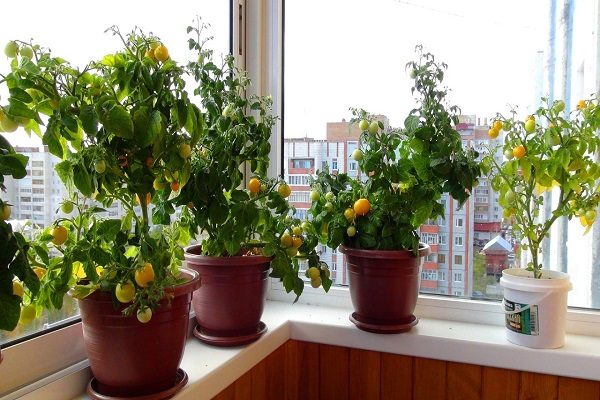
Tomatoes do not belong to tropical plants, so they do not require high humidity.Spraying plantings is necessary only with very high dryness. If the temperature drops below +20 degrees, spraying is not carried out so as not to provoke infection with the black leg.
At the time of flowering, it is recommended to spray on the flowers with warm water from a finely dispersed atomizer. Moisture will improve the adherence of pollen to pistils.
Watering
For tomatoes, timely moistening of the soil is important. Moreover, an insufficient amount of moisture leads to premature fall of the fruit at the stage of formation. On flooded tomatoes, late blight or a black leg is more often formed. Therefore, plants are watered only after the soil has dried in a moderate amount.If the temperature regime is observed and the humidity in the apartment is normal, the plants are watered weekly. Additionally, it is allowed to water the bush a day before the transplant, so that it is more convenient to extract it from the pot. For irrigation use settled or filtered water to prevent chlorine from entering the soil.
Top dressing
For the first time, plants are supplied with an additional portion of minerals by diving. For this, the drug “Kornevin” is bred according to the attached instructions and the bushes are shed. For the same purpose use the tool "Rooter".
To enhance the growth of greenery, nitrogen fertilizers are introduced into a constant container between picking and transplanting. After that, mineral complexes are used to stimulate the formation of fruits. It is especially useful to use such top dressing during the flowering period, when the winter crop is just being laid.
Stepson
For winter cultivation at home, low-grade varieties and hybrids are used. Therefore, they do not need pinching, pinching and shaping. But with poor seed quality and irregular constant growth up, pinch the top of the bush.
Additionally, you can cut off the lower tier of the leaves, because there is still little light. To prevent thickening of the bush, frustrated brushes, dried leaves and branches are torn off in time.
It is recommended to tie the bushes to a support stuck in the ground. This will prevent the bushes from falling apart and overturn the pot.
Pest and disease protection
Wondering if it’s possible grow tomatoes on the windowsill in winter, take into account that potted tomatoes need periodic treatment from diseases, because even room conditions do not create full protection from troubles. Most often, tomatoes suffer from late blight. Therefore, it is important to maintain the frequency of irrigation and to prevent stagnation of water in the pan. To protect against this fungus, ventilation helps well.
For preventive treatment, spraying is used with the following solution:
- 1 g of potassium permanganate crystals;
- 3 l of warm water;
- 100 g chopped garlic.
You can detect pests that attacked plants in the wake of their lives. On the back of the leaves, pests lay eggs and larvae. There you can already meet adults. If such a problem is found, the bushes are treated with insecticides or effective folk remedies: soapy solution, infusion of tobacco or garlic.
In the absence of signs of harmful insects, the cause of growth retardation or deformation of the plant is infection. In this case, to solve the problem, the diseased plant is isolated, and the remaining healthy bushes are treated with a disinfectant solution.
Grade selection
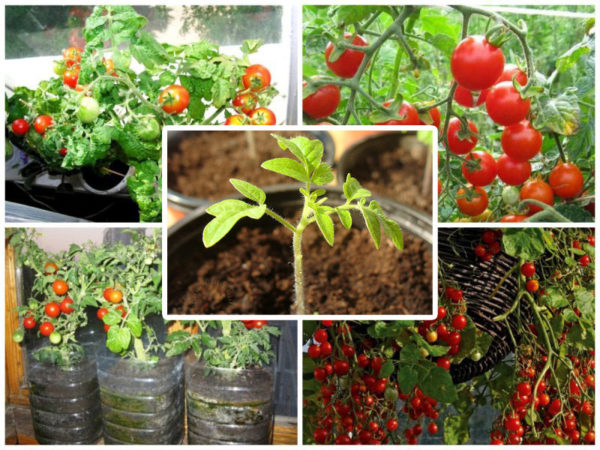 When choosing a tomato variety for growing in winter on a windowsill, it is preferable to use undersized species with high growth rate and good productivity, since the space of the apartment is limited. Such plants do not occupy a significant place and, after a short time, delight with the richness of delicious fruits. The following varieties are most popular for growing houses in winter:
When choosing a tomato variety for growing in winter on a windowsill, it is preferable to use undersized species with high growth rate and good productivity, since the space of the apartment is limited. Such plants do not occupy a significant place and, after a short time, delight with the richness of delicious fruits. The following varieties are most popular for growing houses in winter:
- Balcony miracle forms a compact bush with a height of not more than 0.6 m. Tomatoes are small in size, round, with bright red pulp ripen 3 months after sowing. One plant brings up to 2 kg.
- The non-hybrid variety Dubok forms a bush with a growth of 0.4-0.6 m. It ripens early, forming round fruits with a fleshy inner part. Bushes need to be pollinated artificially, but their advantage is insensitivity to late blight.
- The undersized Ruby Red variety was created specifically for home cultivation. It forms small bushes up to half a meter tall. Small tomatoes have a bright red color and a mild flavor.
- Tomato bushes White filling extend to 70 cm. The ripening period of rounded fruits weighing up to 130 g is 85 days. Fruits with red flesh have a pleasant taste with a slight acidity.
Finally
Growing tomatoes on a window in winter is a great option to always have at hand a supply of fresh and wholesome vegetables, to saturate the body with vitamins on time, and to get a crop of delicious tomatoes before the rest. For people who do not have their own vegetable garden or summer cottage, this is also a good way to practice growing vegetables at home.




 Low-growing tomatoes, without pinching: 5 of the most delicious varieties
Low-growing tomatoes, without pinching: 5 of the most delicious varieties Why tomato seedlings grow poorly
Why tomato seedlings grow poorly We grow a tomato in a shell
We grow a tomato in a shell Growing tomatoes without watering according to the method of Kazarin
Growing tomatoes without watering according to the method of Kazarin